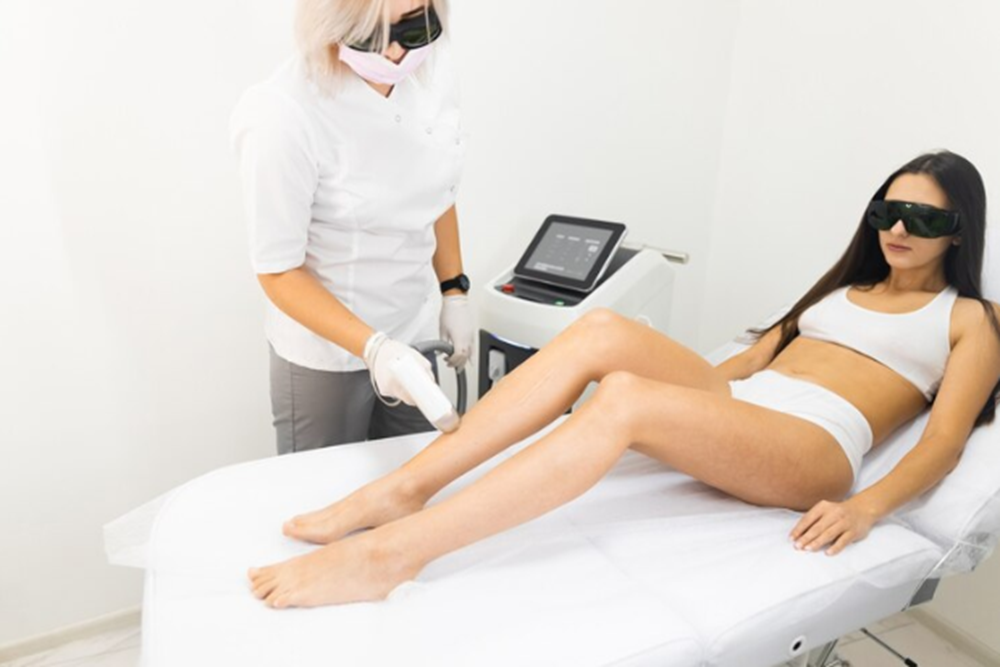I am a dermatologist who has performed hundreds of laser hair reduction procedures in my laser hair reduction clinic in Delhi. Laser hair reduction has revolutionized the approach to unwanted hair, offering a more permanent solution than traditional methods like shaving, waxing, or depilatory creams. In Delhi, laser hair reduction has become quite popular. As a dermatologist who has performed hundreds of laser hair reduction procedures in Delhi, I’d like to share insights into how laser hair reduction works, its benefits, limitations, and what patients should expect.
The Science Behind Laser Hair Reduction
Laser hair reduction works on the principle of selective photothermolysis. The laser emits a specific wavelength of light that is absorbed by the melanin (pigment) in the hair follicle. This light energy converts to heat, which damages the hair follicle and inhibits or delays future hair growth without harming the surrounding skin.
The Treatment Process
A typical laser hair reduction treatment involves:
-Initial Consultation: A thorough assessment of the patient’s skin type, hair colour, medical history, and expectations. This helps determine the most appropriate laser system and treatment parameters.
-Pre-treatment Guidelines: Patients are advised to:
– Avoid sun exposure for 4-6 weeks before treatment
– Discontinue plucking, waxing, or electrolysis for 4-6 weeks (shaving is permitted)
– Stop using retinoids, glycolic acids, or other photosensitizing medications
– Shave the treatment area 24-48 hours before the procedure
The Procedure: During treatment, we apply the laser to the target area. Many modern devices include cooling mechanisms to protect the skin and minimize discomfort. Patients typically experience a sensation similar to a rubber band snap with each pulse.
Post-treatment Care: Following treatment, patients may experience temporary redness, swelling, or discomfort, similar to a mild sunburn. Applying cool compresses and moisturizers helps reduce these symptoms. Sun protection is essential during the entire course of treatment.
Treatment Course and Expectations
Hair growth occurs in cycles, and laser treatment is only effective during the active growth phase. Since not all hairs are in this phase simultaneously, multiple sessions are necessary for comprehensive results.
Typically, patients require 6-8 treatments spaced 4-8 weeks apart, depending on the treatment area. Maintenance sessions may be needed annually or biannually thereafter.
Patients should understand that laser hair reduction provides significant hair reduction, not complete hair removal. Most patients experience an 80-90% reduction in hair growth after a full treatment course. The remaining hair is usually finer and lighter.
Efficacy by Body Region
Treatment effectiveness varies by body area:
– Upper lip, chin, underarms, bikini area: Typically respond well with 6-8 treatments
– Arms, legs, back, chest: May require more sessions due to larger areas and variable hair density
– Areas with hormonal influence (like chin in women with PCOS): May require ongoing maintenance
Safety Considerations and Side Effects
When performed by qualified practitioners using appropriate parameters, laser hair reduction is generally safe. However, potential side effects include:
– Temporary effects: Redness, swelling, discomfort
– Pigment changes: Hyperpigmentation or hypopigmentation (usually temporary)
– Rare but serious: Blistering, scarring, infection, or paradoxical hypertrichosis (increased hair growth)
Risk factors for complications include:
– Recent sun exposure
– Certain medications (including tetracyclines, retinoids)
– History of keloid scarring
– Darker skin tones when inappropriate laser systems are used
Patient Selection and Contraindications
Ideal candidates have:
– Dark hair and light skin (though newer technologies accommodate wider ranges)
– Realistic expectations
– No contraindications
Absolute contraindications include:
– Pregnancy
– Active infections in the treatment area
– Photosensitivity disorders
– History of skin cancer in the treatment area
– Certain medications that increase photosensitivity
Cost Considerations
Laser hair reduction represents a significant initial investment compared to traditional hair removal methods, but often proves cost-effective long-term. Prices vary widely based on:
– Geographic location
– Treatment area size
– Number of sessions required
– Type of laser technology used
– Provider qualifications
Technological Advances
Recent innovations have improved both safety and efficacy:
– Faster treatment times with larger spot sizes
– Better cooling systems for comfort
– Devices capable of treating multiple skin tones safely
– Combined wavelength systems for optimized results
Choosing a Provider
For optimal results and safety, people should seek laser hair reduction in Delhi from qualified dermatologists.
Conclusion
Laser hair reduction offers a scientifically proven, long-term solution for unwanted hair. While not completely permanent, it provides significant reduction in hair growth and freedom from daily shaving or painful waxing. For most patients, the investment in time and money yields satisfying results that improve quality of life.
As with any medical procedure, successful outcomes depend on appropriate patient selection, realistic expectations, and treatment by qualified providers using suitable technology. When these conditions are met, laser hair reduction stands as one of the most successful and satisfying cosmetic procedures available today.
For those bothered by unwanted hair, I recommend consulting a qualified dermatologist to determine if laser hair reduction is right for them and to develop a personalized treatment plan tailored for their specific needs and goals.








